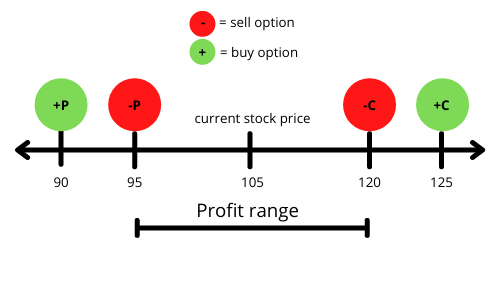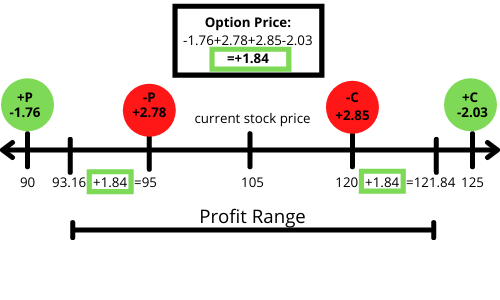When I first opened my brokerage account, iron condors were the first strategy I learned after I lost my luck in buying calls and puts. For this reason, I am excited to teach the strategy that has made me more money- more safely, than any other strategy in my portfolio. If you are a beginner trader, iron condors are the right place to start and in this article I am going to explain the basics of this trade so you can leave this article with an understanding of how it works.
What Is An Iron Condor
An iron condor is what we call a defined risk trade, meaning that we know going into the trade the max amount of money we can lose. We also can place this trade with a smaller amount of money. In this article I am going to go over 3 things, the directional assumption, how the trade is set up, and how we make money.
1. Directional Assumption
Neutral- If you have no idea whether a stock price is going to go up or down, an iron condor may be your best bet.
2. How is it set up?
In words, an iron condor involves selling a far OTM put spread while simultaneously selling a far OTM call spread. This gives you a far range of prices that a stock price can go. I know in words this seems complicated, but look at the image below for a clear understanding.

Quite simply our goal is for the stock price to stay in this range of numbers shown above.
3. How do we make money?
This section involves some math.. which is honestly all calculated in by your brokerage platform. But if you are curious, I have included an example of a trade I placed this morning to show you how all the numbers work.

- Max profit: $184
- This is a selling strategy which means that we collect money when we place the trade. Our max profit is equal to the premium collected when the trade is placed
- Math is simple- just combine the costs of the individual options you bought with the money collected from the options you sold
- Breakevens: 93.16 and 121.84
- So because we collected $1.84 for this trade, the stock price can go outside of our short positions by 1.84 before our option is OTM, or a loser
- Math: 120+1.84= 121.84, 95-1.84=93.16
- Max loss: 309
- This is just calculated by my brokerage, and honestly there is no benefit in explaining the math here
- Spread: 5 point spread
- Distance between short a long put, which is also the distance between the short and long call
- 95-90=125-120 =5
- The larger the spread, the larger the max profit and max loss
Main Point** If your option expires between the numbers calculated in the breakeven section you will earn max profit
Summary
An iron condor is a strategy which allows us to define our max loss, and have a range of numbers for which the stock price can go in order for us to make our money.
- Directional assumption- neutral
- This is set up by selling a far OTM put spread and a far OTM call spread
- You make money as long as the stock price stays in-between your two short positions, and allows a little bit of wiggle rom from the premium you received from placing the trade
While this was a basic overview of this strategy and how it works, my next article will go over my personal checklist for placing this trade.
